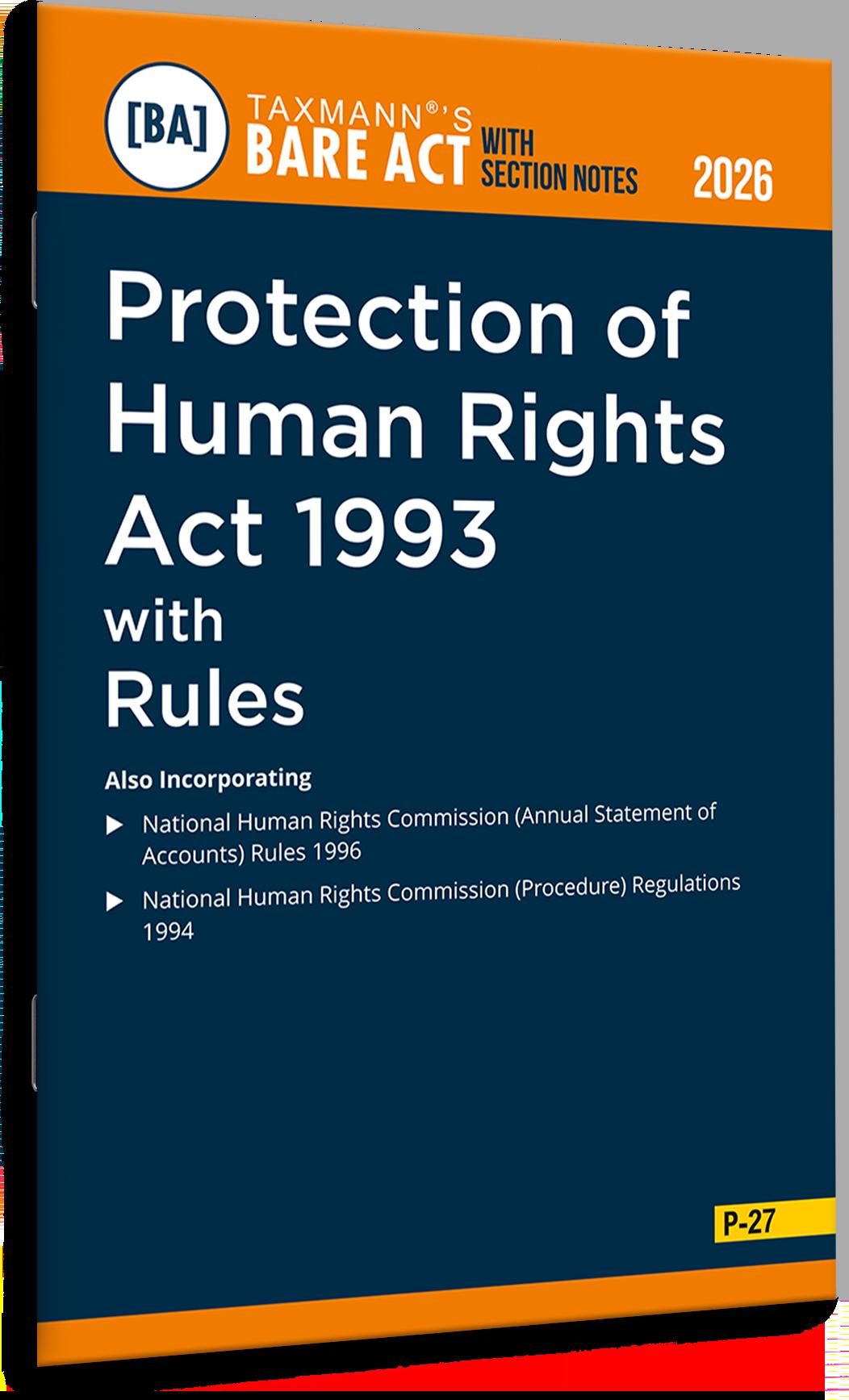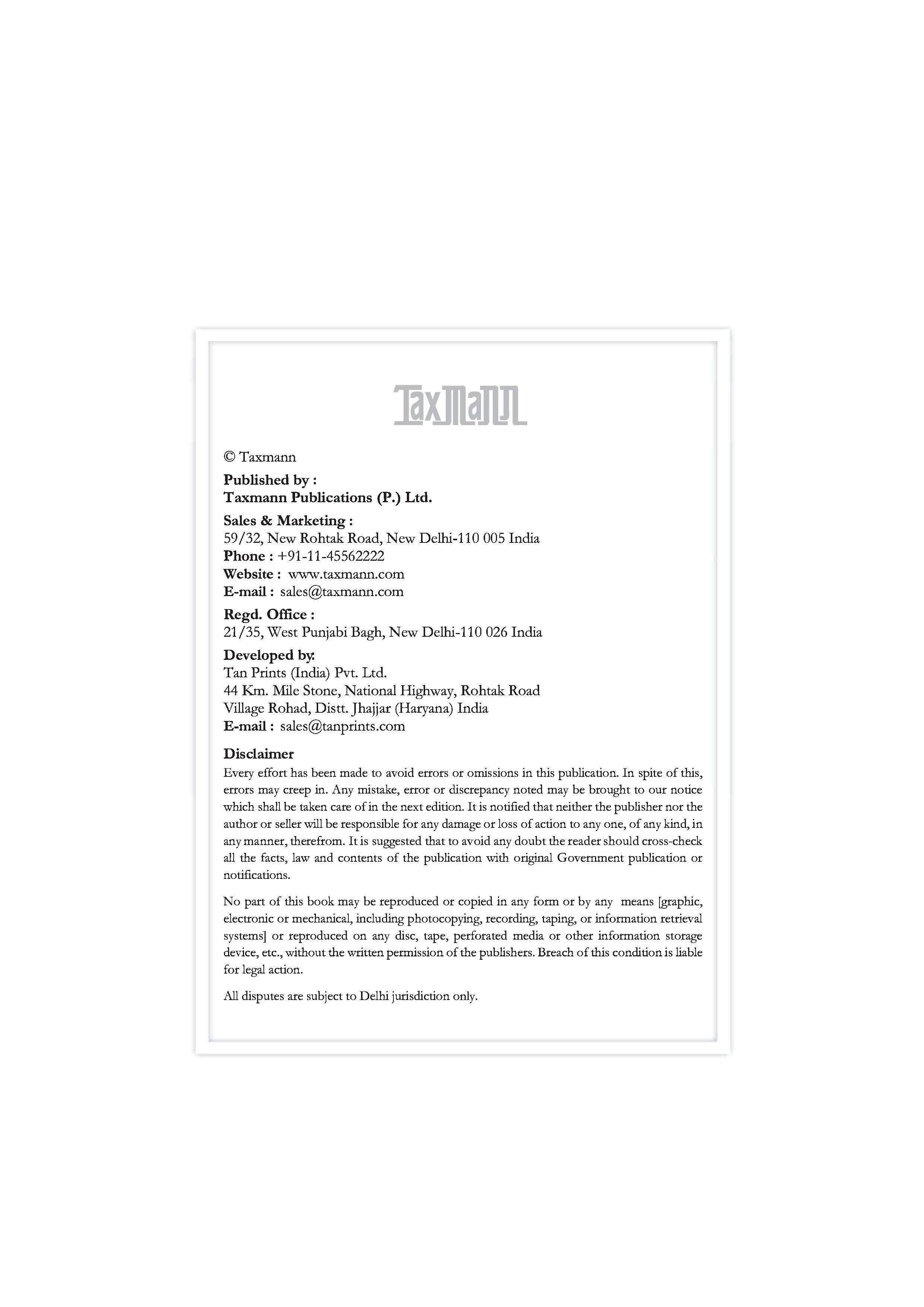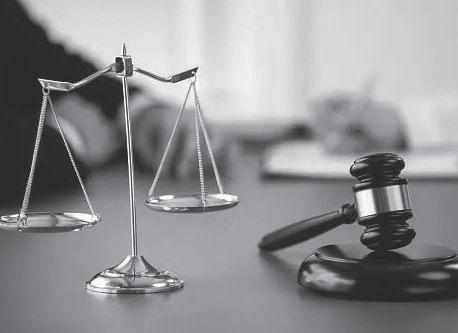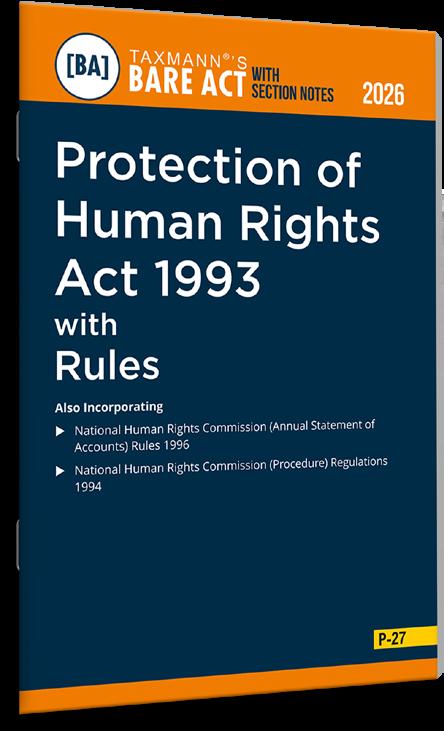Protection of Human Rights Act, 1993
[10 OF 1994]1
An Act to provide for the constitution of a National Human Rights Commission, State Human Rights Commissions in States and Human Rights Courts for better protection of human rights and for matters connected therewith or incidental thereto.
BE it enacted by Parliament in the Forty-fourth Year of the Republic of India as follows:
CHAPTER I PRELIMINARY
Short title, extent and commencement.
1. (1) This Act may be called the Protection of Human Rights Act, 1993.
(2)It extends to the whole of India.
2[***]
(3)It shall be deemed to have come into force on the 28th day of September, 1993. Definitions.
2. (1) In this Act, unless the context otherwise requires,—
(a) “armed forces” means the naval, military and air forces and includes any other armed forces of the Union;
(b) “Chairperson” means the Chairperson of the Commission or of the State Commission, as the case may be;
3[(ba) “Chief Commissioner” means the Chief Commissioner for Persons with Disabilities referred to in sub-section (1) of section 74 of the Rights of Persons with Disabilities Act, 2016 (49 of 2016);]
1.Dated 8-1-1994.
2. Proviso omitted by the Jammu and Kashmir Reorganisation Act, 2019, w.e.f. 31-10-2019. Prior to its omission, proviso read as under:
“Provided that it shall apply to the State of Jammu and Kashmir only insofar as it pertains to the matters relatable to any of the entries enumerated in List I or List III in the Seventh Schedule to the Constitution as applicable to that State.”
3.Inserted by the Protection of Human Rights (Amendment) Act, 2019, w.e.f. 2-8-2019.
S. 2
(c) “Commission” means the National Human Rights Commission constituted under section 3;
(d) “Human Rights” means the rights relating to life, liberty, equality and dignity of the individual guaranteed by the Constitution or embodied in the International Covenants and enforceable by courts in India;
(e) “Human Rights Court” means the Human Rights Court specified under section 30;
4[(f) “International Covenants” means the International Covenant on Civil and Political Rights and the International Covenant on Economic, Social and Cultural Rights adopted by the General Assembly of the United Nations on the 16th December, 1966 and such other Covenant or Convention adopted by the General Assembly of the United Nations as the Central Government may, by notification, specify;]
5[(g) “Member” means a Member of the Commission or of the State Commission, as the case may be;]
6[(ga) “National Commission for Backward Classes” means the National Commission for Backward Classes constituted under section 3 of the National Commission for Backward Classes Act, 1993 (27 of 1993);]
(h) “National Commission for Minorities” means the National Commission for Minorities constituted under section 3 of the National Commission for Minorities Act, 1992 (19 of 1992);
6[(ha) “National Commission for Protection of Child Rights” means the National Commission for Protection of Child Rights constituted under section 3 of the Commissions for Protection of Child Rights Act, 2005 (4 of 2006);]
7[(i) “National Commission for the Scheduled Castes” means the National Commission for the Scheduled Castes referred to in article 338 of the Constitution;
(ia) “National Commission for the Scheduled Tribes” means the National Commission for the Scheduled Tribes referred to in article 338A of the Constitution;]
4. Substituted by the Protection of Human Rights (Amendment) Act, 2006, w.e.f. 23-11-2006.
Prior to its substitution, clause (f) read as under:
‘(f) “International Covenants” means the International Covenant on Civil and Political Rights and the International Covenant on Economic, Social and Cultural Rights adopted by the General Assembly of the United Nations on the 16th December, 1996;’
5. Substituted, ibid. Prior to its substitution, clause (g) read as under:
‘(g) “Member” means a Member of the Commission or of the State Commission, as the case may be, and includes he Chairperson;’
6. Inserted by the Protection of Human Rights (Amendment) Act, 2019, w.e.f. 2-8-2019.
7. Substituted by the Protection of Human Rights (Amendment) Act, 2006, w.e.f. 23-11-2006. Prior to its substitution, clause (i) read as under:
‘(i) “National Commission for the Scheduled Cases and Scheduled Tribes” means the National Commission for the Scheduled Cases and Scheduled Tribes referred to in article 338 of the Constitution;’
PROTECTION OF HUMAN RIGHTS ACT, 1993 S. 2
(j) “National Commission for Women” means the National Commission for Women constituted under section 3 of the National Commission for Women Act, 1990 (20 of 1990);
(k) “notification” means a notification published in the Official Gazette;
(l) “prescribed” means prescribed by rules made under this Act;
(m) “public servant” shall have the meaning assigned to it in section 21 of the Indian Penal Code (45 of 1860);
(n) “State Commission” means a State Human Rights Commission constituted under section 21.
(2) Any reference in this Act to a law, which is not in force in the State of Jammu and Kashmir, shall, in relation to that State, be construed as a reference to a corresponding law, if any, in force in that State.
COMMENTS
SECTION NOTES
2.1 Definition of Human Rights [Section 2(d)]
Human Rights means the rights related to an individual’s life, liberty, equality, and dignity.
These rights are either:
Guaranteed by the Constitution of India.
Embodied in International Covenants and are enforceable by courts in India.
2.2 Definition of international Covenants [Section 2(f)]
The term International Covenants refers to two specific documents adopted by the United Nations General Assembly on December 16, 1966:
The International Covenant on Civil and Political Rights.
The International Covenant on Economic, Social and Cultural Rights.
The term also includes any other Covenant or Convention adopted by the UN General Assembly that the Central Government may specify via a notification.
CASE LAWS
Right to property as a human right - The appellants, illiterate farmers, were dispossessed of their agricultural land by State authorities in 1964 without initiating any acquisition proceedings under law. Despite the issuance of a notification in 1981 to regularise the acquisition, no further steps were taken, and the appellants remained uncompensated while similarly placed persons were paid in 1966. The High Court rejected their compensation claim in 2009 on the ground of delay. Reversing that decision, the Supreme Court held that the right to property, though no longer a fundamental right, is a human right within the scope of section 2(d) of the Protection of Human Rights Act, 1993. It ruled that no citizen can be deprived of property without following due process, and delay or laches cannot defeat a valid claim where constitutional or human rights have been violated. The State’s inaction and unjust enrichment at the cost of the poor amounted to abuse of power. The Court directed the State to initiate acquisition proceedings, award compensation at prevailing market value, and complete the process promptly. - Tukaram Kana Joshi Power of Attorney Holder v. M.I.D.C. AIR 2013 SUPREME COURT 565.
LADAKH (UT)
Section 2
Omit sub-section (2) - [Vide Union Territory of Ladakh Reorganisation (Adaptation of Central Laws) Order, 2020, w.e.f. 23-10-2020)].
CHAPTER II
THE NATIONAL HUMAN RIGHTS COMMISSION
Constitution of a National Human Rights Commission.
3. (1) The Central Government shall constitute a body to be known as the National Human Rights Commission to exercise the powers conferred upon, and to perform the functions assigned to, it under this Act.
(2) The Commission shall consist of—
(a) a Chairperson who has been a 8[Chief Justice of India or a Judge] of the Supreme Court;
(b) one Member who is, or has been, a Judge of the Supreme Court;
(c) one Member who is, or has been, the Chief Justice of a High Court;
(d) 9[three Members out of which at least one shall be a woman,] to be appointed from amongst persons having knowledge of, or practical experience in, matters relating to human rights.
(3) The Chairpersons of 10[,the National Commission for Backward Classes, the National Commission for Minorities, the National Commission for Protection of Child Rights], 11[the National Commission for the Scheduled Castes, the National Commission for the Scheduled Tribes] 12[the National Commission for Women and the Chief Commissioner for Persons with Disabilities] shall be deemed to be Members of the Commission for the discharge of functions specified in clauses (b) to (j) of section 12.
(4) There shall be a Secretary-General who shall be the Chief Executive Officer of the Commission and 13[shall, subject to control of the chairperson, exercise all ad-
8. Substituted for “Chief Justice” by the Protection of Human Rights (Amendment) Act, 2019, w.e.f. 2-8-2019.
9. Substituted for “two members”, ibid
10. Substituted for “the National Commission for Minorities”, ibid
11. Substituted for “the National Commission for the Scheduled Castes and Scheduled Tribes” by the Protection of Human Rights (Amendment) Act, 2006, w.e.f. 23-11-2006.
12. Substituted for “and the National Commission for Women” by the Protection of Human Rights (Amendment) Act, 2019, w.e.f. 2-8-2019.
13. Substituted for “shall exercise such powers and discharge such functions of the Commission (except judicial functions and the power to make regulations under section 40B) as may be delegated to him by the commission or the chairperson, as the case may be” by the Protection of Human Rights (Amendment) Act, 2019, w.e.f. 2-8-2019.
ministrative and financial powers (except judicial functions and the power to make regulations under section 40B)].
(5) The headquarters of the Commission shall be at Delhi and the Commission may, with the previous approval of the Central Government, establish offices at other places in India.
Appointment of Chairperson and other Members.
4. (1) The Chairperson and 14[the Members] shall be appointed by the President by warrant under his hand and seal:
Provided that every appointment under this sub-section shall be made after obtaining the recommendations of a Committee consisting of—
(a)the Prime Minister—chairperson;
(b)Speaker of the House of the People—member;
(c)Minister in-charge of the Ministry of Home Affairs in the Government of India —member;
(d)Leader of the Opposition in the House of the People—member;
(e)Leader of the Opposition in the Council of States—member;
(f)Deputy Chairman of the Council of States—member:
Provided further that no sitting Judge of the Supreme Court or sitting Chief Justice of a High Court shall be appointed except after consultation with the Chief Justice of India.
(2) No appointment of a Chairperson or a Member shall be invalid merely by reason of any 15[vacancy of any member in the Committee referred to in the first proviso to sub-section (1)].
16[Resignation and removal of Chairperson and Members.
5. (1) The Chairperson or any Member may, by notice in writing under his hand addressed to the President of India, resign his office.
(2) Subject to the provisions of sub-section (3), the Chairperson or any Member shall only be removed from his office by order of the President of India on the ground of proved misbehaviour or incapacity after the Supreme Court, on refer-
14. Substituted for “other Members” by the Protection of Human Rights (Amendment) Act, 2006, w.e.f. 23-11-2006.
15. Substituted for “Vacancy in the Committee”, ibid
16. Substituted by the protection of Human Rights (Amendment) Act, 2006, w.e.f. 23-11-2006. Prior to its substitution, section 5 read as under:
“5. Removal of a Member of the Commission.—(1) Subject to the provisions of sub-section (2), the Chairperson or any other Member of the Commission shall only be removed from his office by order of the President on the ground of proved misbehaviour or incapacity, after the Supreme Court, on reference being made to it by the President has on inquiry held in accordance with the procedure prescribed in that behalf by the Supreme Court, reported that the Chairperson or such other Member, as the case may be, ought on any such ground to be removed.
(Contd. on page 6)
ence being made to it by the President, has, on inquiry held in accordance with the procedure prescribed in that behalf by the Supreme Court, reported that the Chairperson or the Member, as the case may be, ought on any such ground to be removed.
(3) Notwithstanding anything in sub-section (2), the President may, by order, remove from office the Chairperson or any Member if the Chairperson or such Member, as the case may be,—
(
a) is adjudged an insolvent; or
(b) engages during his term of office in any paid employment outside the duties of his office; or
(
c) is unfit to continue in office by reason of infirmity of mind or body; or
(
d) is of unsound mind and stands so declared by a competent court; or
(e) is convicted and sentenced to imprisonment for an offence which in the opinion of the President involves moral turpitude.]
COMMENTS
CASE LAWS
Removal of NHRC Chairperson – President’s discretion cannot be compelled by court - A writ petition was filed seeking a mandamus to direct the President of India to make a reference to the Supreme Court for an inquiry into allegations of serious misconduct against the then Chairman of the National Human Rights Commission, Justice K.G. Balakrishnan. The petitioner relied on Section 5(2) of the Protection of Human Rights Act, 1993, which provides that the Chairperson can be removed only after a Supreme Court inquiry initiated upon a reference made by the President. The Supreme Court refused to entertain the prayer for a mandamus, holding that such a reference depends on the President’s satisfaction, which in turn is guided by the advice of the Council of Ministers. The Court emphasized that it cannot compel the President to act in a particular manner under this provision, especially when the writ petition did not disclose whether any deliberations were held by the President or Council of Ministers regarding the complaint. Accordingly, the petition was disposed of with a direction that the competent authority may consider the complaint and inform the petitioner of the outcome. - Common Cause v. Union of India AIR 2012 SUPREME COURT 2240.
(Contd. from page 5)
(2) Notwithstanding any thing in sub-section (1), the President may by order remove from office the Chairperson or any other Member if the Chairperson or such other Member, as the case may be,—
(a) is adjudged an insolvent; or
(b) engages during his earn of office in any paid employment outside the duties of his office; or
(
c) is unfit to continue in office by reason of infirmity of mind or body; or
(d) is of unsound mind and stands so declared by a competent court; or
(e) is convicted and sentenced to imprisonment for an offence which in the opinion of the President involves moral turpitude.”










